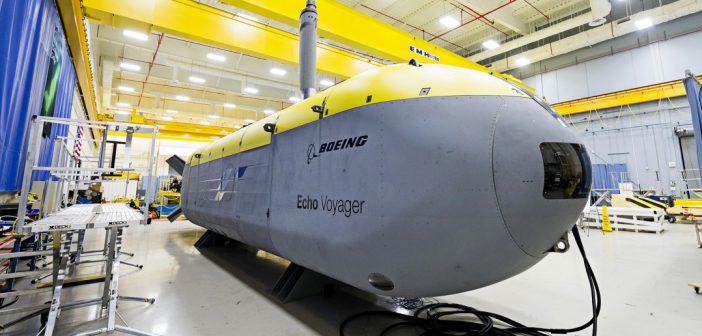Gramps was once again fascinated by the advances in scientific as well as military technology presented by Fred Sheldon, the program manager for Autonomous Undersea Vehicles such as the Boeing Echo Voyager, an AUV. The vehicles in the presentation were created by Boeing at its own expense for future use by the military as well as scientific purposes.
 Fred began with the AN/BLQ-11, a unit that was designed for long term mine reconnaissance. It is launched through a submarine’s torpedo tube with a size of 21 inches X 20 feet and a weight of 12,800 pounds. It has a 5 hour roaming endurance capability after which it is recovered by the sub through a torpedo tube.
Fred began with the AN/BLQ-11, a unit that was designed for long term mine reconnaissance. It is launched through a submarine’s torpedo tube with a size of 21 inches X 20 feet and a weight of 12,800 pounds. It has a 5 hour roaming endurance capability after which it is recovered by the sub through a torpedo tube.
 The next item was the “Echo Ranger”, a larger and more capable device for commercial oil and gas surveys. It has dimensions of 4 feet X 4 feet X18.5 feet, weighs 977 pounds dry and can work at a depth of 10,000 feet. It was used to explore and capture the sonar images of the U.S.S. Independence, an aircraft carrier that was scuttled near Half Moon Bay in 1951. Fred showed the high resolution sonar images of the remainder of the ship in its resting place underwater. The sensor device was the Coda Octopus high resolution echoscope that produced 3-D images of the sunken ship.
The next item was the “Echo Ranger”, a larger and more capable device for commercial oil and gas surveys. It has dimensions of 4 feet X 4 feet X18.5 feet, weighs 977 pounds dry and can work at a depth of 10,000 feet. It was used to explore and capture the sonar images of the U.S.S. Independence, an aircraft carrier that was scuttled near Half Moon Bay in 1951. Fred showed the high resolution sonar images of the remainder of the ship in its resting place underwater. The sensor device was the Coda Octopus high resolution echoscope that produced 3-D images of the sunken ship.
 Another project was the “Echo Seeker”, a large Displacement Unmanned Underwater Vehicle (“LDUUV”). Its dimensions are 6 feet X 6 feet X 32 feet and it has a 20,000 foot depth capability. It is a high level autonomy testbed. Its SONAR resolution is 3 inches at depth. It requires a manned platform on shipboard to manage its procedures. Its operational cost is $130,000 per day!
Another project was the “Echo Seeker”, a large Displacement Unmanned Underwater Vehicle (“LDUUV”). Its dimensions are 6 feet X 6 feet X 32 feet and it has a 20,000 foot depth capability. It is a high level autonomy testbed. Its SONAR resolution is 3 inches at depth. It requires a manned platform on shipboard to manage its procedures. Its operational cost is $130,000 per day!
 The next design is the “Echo Voyager” that has dimensions of 51 feet long. Its depth capability is 11,000 feet. It has rechargeable batteries as well as liquid fuel that gives it a 90 day operational duration and a range of 150 nautical miles unrecharged with a total range with repeated surface recharging of 7000 nm. Its operating speed is 3-8 knots with 3 being the normal to keep power consumption lower. It has two snorkels and one fuel tank and has an “X” shaped set of tailfins that allow it to continue to function even if the tail is damaged. It has a very quiet operating noise level even with the diesel engine running. It has the capability of deploying payloads for antisubmarine warfare as well as for patrol. It is equipped with magnetic as well as gyro compasses and can establish its position while on the surface with GPS as well as remote setting. Its operational abilities are destroyed if it is recycled to protect the technology if captured. It uses AIS auto identification equipment to locate and track nearby ships. The construction is of a metal and carbon fiber with multiple internal watertight compartments that are pressurized to allow descent into great depths. It uses a Lithium Polymer battery that has extensively been demonstrated to be safe as opposed to the lithium ion batteries that have had major fire problems. This is all from Boeing and all this comes from Southern California facilities.
The next design is the “Echo Voyager” that has dimensions of 51 feet long. Its depth capability is 11,000 feet. It has rechargeable batteries as well as liquid fuel that gives it a 90 day operational duration and a range of 150 nautical miles unrecharged with a total range with repeated surface recharging of 7000 nm. Its operating speed is 3-8 knots with 3 being the normal to keep power consumption lower. It has two snorkels and one fuel tank and has an “X” shaped set of tailfins that allow it to continue to function even if the tail is damaged. It has a very quiet operating noise level even with the diesel engine running. It has the capability of deploying payloads for antisubmarine warfare as well as for patrol. It is equipped with magnetic as well as gyro compasses and can establish its position while on the surface with GPS as well as remote setting. Its operational abilities are destroyed if it is recycled to protect the technology if captured. It uses AIS auto identification equipment to locate and track nearby ships. The construction is of a metal and carbon fiber with multiple internal watertight compartments that are pressurized to allow descent into great depths. It uses a Lithium Polymer battery that has extensively been demonstrated to be safe as opposed to the lithium ion batteries that have had major fire problems. This is all from Boeing and all this comes from Southern California facilities.
We thank Fred for his work and his presentation to our meeting about some of the things that no matter how long at sea, we cannot see, but they are really there.





